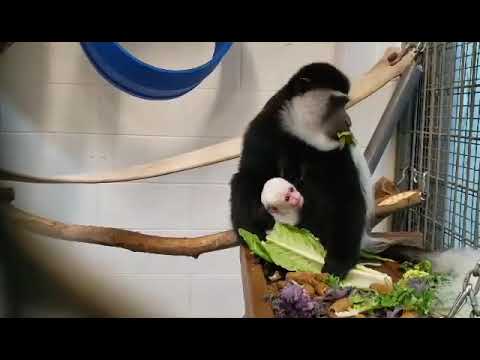Summary:
– Introduction to the New Colobus Baby and its mother
– Description of the unique characteristics and adaptations of colobus monkeys
– An exploration of the importance of colobus monkeys in their ecosystem
– The challenges faced by colobus monkeys in the wild
– The conservation efforts to protect colobus monkeys and their habitat
Welcome, wildlife enthusiasts! Today, we embark on a mesmerizing journey into the intriguing world of the New Colobus Baby and its caring mother. Brace yourself for a wild adventure as we uncover these incredible creatures’ unique and fascinating aspects. From their distinctive appearances to their critical role in the ecosystem, we’ll leave no stone unturned in our exploration.
Let’s begin with a breathtaking introduction to the New Colobus Baby and its nurturing mother. Picture a lush green forest canopy, where branches sway gently in the wind. Amidst this verdant paradise, the New Colobus Baby is nestled close to its mother. These black and white monkeys are a sight to behold, with their majestic coats and long, flowing tails that gracefully help them maintain balance as they leap through the treetops.
Colobus monkeys, named after their Greek translation meaning “mutilated one” due to their thumbless hands, possess fascinating characteristics and adaptations that make them stand out from other primates. Their unique feature lies in their digestive system. Colobus monkeys have a complex stomach divided into compartments, allowing them to specialize in a plant-based diet. This specialization allows them to survive on leaves and fruit, making them remarkable herbivores within the primate world.
Beyond their dietary adaptations, colobus monkeys play an essential role in their ecosystem. As they feast on leaves, they help regulate the forest’s vegetation, shaping its growth and ensuring a healthy balance within the ecosystem. Additionally, the seeds they consume are dispersed through their feces, aiding in germination and the forest’s regeneration. It’s astounding how these innocent herbivores can indirectly shape their habitat.
However, life in the wild has challenges for the New Colobus Baby and its kin. Rapid deforestation and habitat loss have pushed these graceful creatures to the brink. The encroachment of human settlements, logging, and agricultural expansion significantly reduce their natural habitat and disrupt their delicate balance. Furthermore, their striking black and white fur, desired for its aesthetic value, has made them a target of the illegal wildlife trade. These threats put their populations at risk, underscoring the urgent need for conservation efforts.
Despite these challenges, hope prevails as conservationists tirelessly work to protect the New Colobus Baby and its family. Local communities, wildlife organizations, and governments unite to safeguard their habitat and educate people about the importance of these gentle creatures. From establishing protected areas to implementing sustainable farming practices that minimize habitat destruction, these initiatives serve as beacons of hope for the future of colobus monkeys.
By learning about and appreciating these remarkable animals, we can contribute to their preservation. Spread awareness, support conservation organizations, and advocate for sustainable practices to protect the New Colobus Baby and its fellow primates. Remember, no matter how small, every action can make a difference in ensuring a brighter future for these endangered beings.
As we conclude our fascinating journey, take a moment to reflect on the importance of colobus monkeys in the web of life. Let their unique adaptations and critical role in their ecosystem inspire and motivate us to be better stewards of the natural world. Together, we can champion their cause and safeguard the rich biodiversity that makes our planet a truly remarkable place.
*****
Source Description


